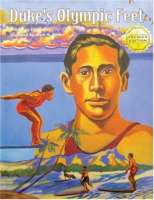
Duke’s Olympic Feet
Written by Ellie Crowe
Illustrated by Mark N. Brown
Island Heritage, 2002, 44 pp, ISBN 10: 0-89610-392-7
This biographical picture book of Hawai`i’s Olympic swim champion and internationally recognized surfer Duke Kahanamoku chronicles five key events which occurred in his life between 1911 and 1914. This historical description highlights Duke’s accomplishments as the first person of native Hawaiian ancestry to win an Olympic gold medal and distinguishes him as the “Father of Surfing.” In the opening story, the reader experiences Duke’s whirlwind of emotions as he breaks a world record for swimming the 100 yard freestyle and is soon crushed when the Amateur Athletic Union refuses to accept his time and tells him, “What do you use for stopwatches over there in Hawai`i — alarm clocks?” To prove his talent as a swimmer Duke travels to unfamiliar and faraway places — Chicago, Pittsburg, and Stockholm, where he must overcome the obstacles presented to him. Unprepared for the cold weather, Duke stuffs cardboard under his thin jacket to keep warm. Fatigued by the lengthy travel, he nearly sleeps through the Olympic competition. Despite the challenges faced, Duke returns to Hawai`i with a gold medal. The last story describes Duke’s travels to Australia and details how he introduced the Aussies to surfing.
As a picture book, Duke’s Olympic Feet is a fascinating historical look at Duke Kahanamoku’s life made accessible to young readers. This story emphasizes humility in victory, courage of traveling to new places, perseverance in the face of adversity. The chronological structure of the story allows the reader to experience several important moments in Kahanamoku’s life that take place over a period of time. The structure of the story also allows the author to juxtapose Kahanamoku’s travel experiences with his laid back lifestyle in Hawai`i. Crowe raises the issue of proving oneself and representing his/her race through sport. She provides the reader with opportunities to empathize with the challenges such as racial name calling, yet provides the reader with hope in including positive experiences with others who help.
Readers of native Hawaiian ancestry have not raised issues of cultural accuracy or authenticity and have been pleased with the presentation of the Hawaiian lifestyle and with how Kahanamoku’s attitudes and values are woven throughout the story. Readers also appreciate that the book ends with Duke’s thoughts on aloha, “In Hawai`i we greet friends, loved ones or strangers with aloha, which means love. Aloha is the key word to the universal spirit of real hospitality, which makes Hawai`i renowned as the world’s center of understanding and fellowship. Try meeting or leaving people with aloha, you’ll be surprised by their reaction. I believe it and it is my creed.”
This book can be read with the story of baseball player Jackie Robinson’s, Teammates (Golenbock, 1992) which describes Robinson’s challenges as an African American trying to break racial barriers through sports. Both books emphasize good sportsmanship as the characters struggle to prove themselves as athletes in a world that can be filled with racial discrimination.
Michele Ebersole, University of Hawaii at Hilo, Hilo, HI
WOW Review, Volume I, Issue 1 by Worlds of Words is licensed under a Creative Commons Attribution-NonCommercial-ShareAlike 4.0 International License. Based on work at https://wowlit.org/on-line-publications/review/i-1/
